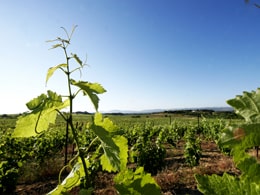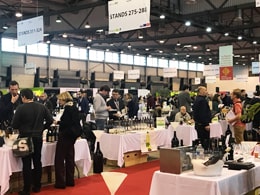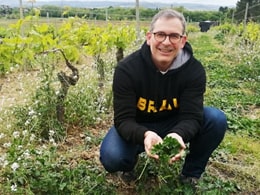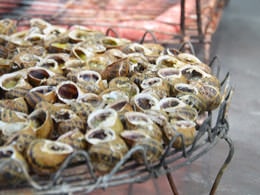Special feature on wine producing regions: "Languedoc-Roussillon"

About Languedoc-Roussillon wine


The Languedoc-Roussillon region stretches from the southwest to the south of France, from near Montpellier to adjacent to the border with Spain.
The region's climate, with its sunny summers, dry air, and wet winters, is ideal for growing grapes, and it is the largest wine-producing region in France.
While the high temperatures typical of the south are ideal for growing grapes, the temperatures are also high during harvest and preparation, so in the past, when there was no cooling equipment, the quality of the wine was not very high, and mainly table wine and bulk wine for blending were produced.
However, in recent years, a number of up-and-coming producers have been attracted to the region's free-flowing winemaking environment, which is not found in Bordeaux or Burgundy, and are working to pursue their own ideals by creating wines that are unique to them.
Thanks to healthy grapes and advanced brewing techniques, the region has been attracting a lot of attention in recent years as a place where you can enjoy wines that are affordable yet full of the producer's attention to detail.
In other words, the Languedoc-Roussillon region is the place where you are most likely to find wines that offer excellent value for money .
This region is home to a wide variety of new and old wines, so you're sure to find your favorite one.
- Key points about the production area
- Mavi Wine Producers
- Enjoy wine and gourmet food
- Recommended Wine
Languedoc-Roussillon wine highlights


Located in the southwestern to southern part of France, Languedoc-Roussillon has a hot, dry climate, making it an ideal environment for growing grapes.
2. From table wine to special wine makingLanguedoc-Roussillon used to be a region that mainly produced inexpensive table wine and wine sold in bulk, but since around 1980, up-and-coming producers have entered the market and begun to produce high-quality wines.
3. A pioneering place for organic wineLanguedoc-Roussillon's hot, dry climate means that the risk of grape disease is low, making it ideal for organic cultivation with limited use of chemical fertilizers and pesticides.
1. Climate suitable for grape cultivation


Languedoc-Roussillon has been a center of civilization since prehistoric times, with Greek, Roman, and Carthaginian influences passing through, and grape cultivation was introduced to the region early on.
It has a hot, dry climate that is ideal for growing grapes, and is also the largest wine-producing region in France .
Additionally, some areas are influenced by both the Mediterranean and Atlantic climates, making it possible to cultivate a wide variety of grape varieties.
2. From table wine to special wine making


While the high temperatures typical of the southern region of Languedoc-Roussillon make it ideal for growing grapes, even in September, the harvest and preparation season, temperatures are higher than in other wine-producing regions. In the past, when there was no cooling equipment, most of the wine produced in this region was inexpensive table wine .
As a result, even though it is the largest wine producing region in France, it has not often been mentioned in the same light as high-end wine regions such as Bordeaux and Burgundy.
However, since the 1980s, winemaking in this region has been boosted by a number of progressive wine growers and brewers who are attracted by the region's climate, which is suitable for a variety of grape varieties, and the relatively free atmosphere for winemaking, and are pursuing their ideal wines .
3. A pioneering place for organic wine


Languedoc-Roussillon is also a pioneer of organic winemaking in France .
Many wine farmers have ended up with organic farming in their pursuit of the ideal winemaking. In addition, an increasing number of wine farmers are choosing organic farming as an added value to compete with high-end wine producing regions.
The hot, dry climate of the region reduces the risk of grapes becoming diseased, so there is less need to use pesticides to prevent disease. The Languedoc-Roussillon region has long been suitable for grape growing, and is also well suited to organic farming, which produces "what suits the land without overdoing it."
In addition, Millesime Bio, the world's largest organic wine trade fair, in which many Mavi producers participate, is held every January in Montpellier, the capital of the Languedoc-Roussillon region.
This fair was started in 1993 by a group of organic wine growers in the Languedoc-Roussillon region, at a time when organic farming had not yet taken root in France.
When Mavi first visited the fair in 1998, when it was founded as an organic wine specialist, there were only 50 exhibitors, including the Douelle family from Provence and the Achard family from the Rhône, with whom we still have a relationship.
Now, with an increasing number of exhibitors from outside France and the event growing in scale every year, it still retains the same homely atmosphere of the time and continues to lead the organic wine scene today.
Languedoc-Roussillon wine producers in Mavi
Characteristics of the Languedoc region


Languedoc means "Occitan language (Langue d'Oc)" and is a general term for the area where the Occitan language, one of the Romance languages, was once spoken. "Brau", which is also used in the name of the Domaine of the Revol family, producers in the Languedoc region of Mavi, means "bull" in Occitan.
A famous place in this region is Carcassonne. The fortified city of La Cite built in Roman times is registered as a UNESCO World Heritage Site and is the second most popular tourist city in France after Mont Saint-Michel. Walking through the narrow, intricate alleys of La Cite, typical of a fortified city, makes you feel as if you have traveled back in time to the Middle Ages.
The Revol family/Languedoc, France


blow
Carcassonne is a fortified city on the banks of the Aude River in the Languedoc region of southern France, and is a World Heritage Site. From Mr. Revol's vineyard and winery "Brau," you can see the fortified city of Carcassonne and the beautiful mountain range of the Pyrenees.
In fact, this is the Domaine of the former Tali family, who have had a relationship with Mavie since its founding. When the current producer, Mr. Revol, was looking for a vineyard and winery to make wine, which was his long-held dream, he came across Mr. Tali's Domaine, which was for sale. Not only was it organically grown, but it was also planted with many of the varieties necessary for the wine he wanted to make, which was the deciding factor for him to take over.
Although Breau is geographically in the Mediterranean region, it is also influenced by the Atlantic coastal climate, allowing it to grow a wide variety of grape varieties from both the south of France and Bordeaux , including Merlot, Cabernet Sauvignon, Cabernet Franc, Grenache, Syrah, Pinot Noir, Chardonnay, and Roussanne, to name a few.
Revol's winemaking is characterized by " practicing natural farming methods that are even closer to nature than organic cultivation, " "bringing out the natural fruitiness of the grapes without using barrels," and "creating a crisp flavor through low-temperature brewing and strict temperature control."
In addition, they experiment with new wines every year, including the "Nature Series," which contains no added sulfur dioxide .
>>See the list of Revolu wines
Bellu Family/Languedoc, France


Blanket Belyu
Belleu's brewery is located in the village of Roquetaillade, located on a small hill west of Carcassonne. The road to the village is full of scenery with huge rocks, the Sawtooth Fault, and a mountain stream, and the village itself has many rock-made ruins that retain the appearance of the Middle Ages, making it feel like a fortress floating in the sky.
Mr. Belieu is a true craftsman who converted his own fields to organic in 1981 and has also served as chairman of the organic organization Nature & Progres .
He does not use any SO2 (sulfur dioxide) as a preservative, and is quite a stubborn person, saying, "If it's different from my winemaking, I don't need certification, and as long as people who drink it say it's delicious, I'm not interested in medals in competitions."
The small brewery is filled with DIY tanks that give off a handmade feel, and most of the brewing process is done by hand, making mass production impossible.
The slightly sweet sparkling wine made by Belieu is different from the Champagne method in which sugar is added during the process; instead, it retains the natural sweetness of the grapes, and its gentle flavor is recommended even for those drinking wine for the first time.
>>See the list of wines from the Bellu family
Characteristics of Roussillon


The Roussillon region, which borders Spain, was part of Catalonia until it became French territory with the Treaty of the Pyrenees in 1659, and so it still retains strong Catalan influences in its food culture, language, and more.
For example, the name of the Boullier family's chateau, "L'ou", means "egg" in Catalan, and was named after the land where the horses lived, as the pond they used to water was oval in shape and resembled an egg.
The city is also famous for the scenic Mount Canigou, which is considered sacred to the Catalans, and the ruins of a brick castle left behind by the Catalans can be seen in the city of Perpignan.
Boullier family/Roussillon, France


Chateau de Loup
About an hour's drive from Perpignan, the capital of French Catalonia in the Roussillon region, the Boullier family's vineyards and winery are located near land that is said to have been created by the Knights Templar by digging a nearby river.
The winemaking is mainly handled by his wife, Severine, a talented woman who studied oenology at the University of Bordeaux and is a perfectionist who pursues her ideals. He was one of the first to recognize that the hot, dry Mediterranean climate of his vineyards was ideal for organic farming, and he has continued to grow grapes organically ever since he purchased the domaine in 1998.
The strong, supple wines produced in this artistic brewery lined with rainbow-colored tanks have won numerous medals at domestic and international competitions.
Currently, the company also produces premium wines such as " Ipsofact " and " Secre de Sisto ", which bring out the charm of Syrah.
>>Go to the Boullier family wine list
Enjoy Languedoc-Roussillon wine and gourmet food


The Languedoc-Roussillon region, which is home to the Mediterranean Sea and the Pyrenees Mountains, is blessed with both mountain and sea delicacies, and offers a wide variety of local cuisine. Because the ingredients are of high quality, there are many simple recipes in which the fish is grilled or stewed whole.
A specialty of Carcassonne in the Languedoc region is cassoulet, a stew of meat and white beans. The slow-cooked flavor will gently warm you up.


In Roussillon, near the Spanish border, popular Spanish dishes such as gazpacho are also commonly eaten. Burgundy is famous for escargot, but Catalan escargot is seasoned with butter and garlic, drizzled with hot lard, and served with aioli sauce.
Recommended Languedoc-Roussillon wines
Popular Languedoc-Roussillon wines
Sucre de Sisto Red
・Product number: 44021
・Producer: Boullier family
(Roussillon, France)
・Pairs with: stewed lamb, stewed veal, game cooked in red wine, beef stew, cheese, etc.
A dense and complex aroma of stewed black cherries, dried figs, spices such as black pepper and nutmeg, and a slightly wild aroma like coffee, chocolate, and animal meat. It has a supple yet powerful concentrated fruitiness, elegant acidity, and deep richness, making it a satisfying drink. This is a bottle made by a winemaker who is in love with Syrah.
Brand Blow White
・Product number: 73001
・Producer: Revolu family
(Languedoc, France)
・Pairs with: seafood, salads, grilled chicken, cheese with apricot jam, etc.
It also has tropical nuances such as peach, apricot, and fresh pineapple. Behind the impressive fruity aroma, you can also feel the scent of flowers like jasmine. The taste is dry, with a strong acidity that lasts for a long time. It is a simple yet impactful bottle with a moderate drinkability. You can enjoy the change in taste as you drink, so it is a white wine that is easy to approach even for wine novices.
TB Pinot Noir Red
・Product number: 73013
・Producer: Revolu family
(Languedoc, France)
・Pairs with: roast duck, mushroom risotto, creamy cheeses such as brie, etc.
Made with 100% Pinot Noir, it has the aroma of fresh red fruits such as cranberries, and a hint of black fruits on the palate. This is a wine that allows you to enjoy the sharp acidity, umami and fruitiness of grapes bathed in the southern French sun.
Nature Chardonnay White
・Product number: 73033
・Producer: Revolu family
(Languedoc, France)
・Food that goes well with it: Acquapazza, pot-au-feu, yudofu, shirasu oroshi, etc.
Made with 100% Chardonnay, it has a citrus aroma and fruity aromas such as white peach and apricot. Its clean acidity and mild fruitiness make it a perfect match for Japanese food such as yudofu. It is made without any added preservatives.
↑ Top of page | Search for products | Featured items | MAVI mail order TOP


